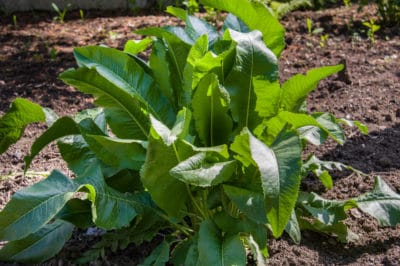Is Horse Radish a Radish?
Horseradish is probably a corruption of an old German word, “meerrettich” or sea radish, which sounds like “mareradish.” Eventually the “mare” became “horse.” It’s actually more closely related to brassicas like mustard, cabbage and cauliflower than the common garden radish. Wasabi, or Japanese horseradish, however, is a different “branch” on the brassica family tree.
Where Can You Grow Horseradish?
Horseradish can be grown in nearly any climate zone. USDA zones 4 to 7 are ideal horseradish climates. In very cold areas, you may want to grow it as an annual or in containers. It is typically hardy to zone 3. It doesn’t do as well in very warm areas such as the desert. However, if you grow it as a winter annual, you may be more successful.
Can I Grow Horse Radish in Containers?
Containers are a good way to keep horseradish from spreading. Make sure the soil is friable and well-prepared with nutrients. The container should drain well. Containers should be at least 30 inches deep; 36 inches is preferable. A wide-mouthed pot or barrel makes it easier to harvest the root. Make sure container-grown horseradish doesn’t dry out or get soggy. Place in full sun or semi-shade.
Is Horseradish a Perennial or an Annual?
Technically, horseradish is a perennial in most climates. However, it can be grown as an annual. One advantage to growing it as a perennial is that you plant it once and let it spread. But horseradish can be invasive, so many people plant it as an annual or in containers to keep the roots contained and easier to harvest. The root can spread to two or three feet in diameter.
What Soil is Best for Horseradish?
The ideal soil for horseradish is moist and silty (think river bottom land). As long as the pH is near neutral, enriched clay or sandy loam are acceptable. However, horse radish will tolerate a wide pH range even if it doesn’t grow as well. Horseradish, like many root crops, needs potassium, moderate phosphorus and low to moderate nitrogen. Use well-aged manure, rotted leaf mulch or compost to add humus.
How Should I Water Horseradish?
Horseradish needs good drainage. Water well after planting the root pieces (called sets). Although the minimum is one inch of irrigation or rain per week, horseradish is perennial, so a steady supply of moisture is important. Check the soil every few days and water if the top inch seems dry. Be extra careful when growing horseradish in containers not to over-water or let it dry out.
When Do I Plant Horseradish?
In most temperate climates, horseradish is planted in the spring. This is true for both annual and perennial plantings. In desert areas, it is best planted in the early fall and grown over the winter. Although horseradish is relatively cold hardy, it’s best to plant soon after the last expected frost date for your area, especially if you are planting in a container.
How Do I Plant Horseradish?
Horseradish can be planted from seeds but in most cases, horseradish seed is sterile. It is more common to plant from pieces of the root known as sets. The nursery or seed house will send you what look like pieces of rough wood. If someone in your area has a plant, you can ask for root divisions. You can also plant pieces of root from the grocery.
What Varieties are Available?
You have several options for horseradish varieties. Most are members of the brassica family.
- Common horseradish or Maliner Kren is most often sold to gardeners because it has good flavor (although low disease resistance.)
- Bohemian horseradish tends to be smaller than the common type. Several cultivars are available.
- Variegata offers striped and splashed leaves.
- Wasabi, although often called “mustard” is a variety from Japan that has a rhizome rather than a root.
How Do I Store Horseradish?
After several frosts have occurred, dig the roots, wash and store in the refrigerator. You can also leave the plants in the ground and dig as needed. Prepared horseradish can also be stored in the refrigerator. Peel and chop the root, then puree in a food processor. Stir in a little salt and a teaspoon of white vinegar. Store in the refrigerator for two weeks. Add mayo or sour cream to make horseradish sauce.
